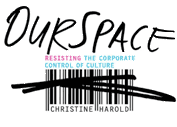OVERVIEW

|
Reviewed by
Marshall Kitchens
In the introduction, Harold establishes a dialectic between Naomi Klein, on the one hand, who argues in No Logo that the branding of late capitalism is a force to be resisted, and on the other hand, philosophers Joseph Heath and Andrew Potter who argue that the unbranded countercultural utopia is a myth – countercultural rhetoric is a posture always already ripe to be co-opted by the likes of Nike and Rupert Murdoch, stripping the public sphere of any genuine political discourse. Klein argues that branding undermines public agency and must be resisted; Heath and Potter fatalistically assert that, in the words of John McCrae, "resistance is useless; it is useless to resist." For every Gill Scott Heron chanting, "The revolution will not be televised," there's a Nike ad agent ready to acquire the music rights to make a commercial.
Harold grants both arguments, to some degree, and establishes her thesis as acknowledging the countercultural rebel as something of a marketing myth, but one that provides “rich political fodder” to convert an ever growing body of culture jammers and revolutionaries who have the potential to enact meaningful social change. The question Harold poses in responding to the “problem of the market” is how do we go beyond these binary opposites of independence verses co-optation to create other modes of resistance within a commodified public sphere? And what does this space look like in which public values of "sharing and openness trump property and profit"?
To illustrate the conflict between the quest for authentic space and the commodification of the public sphere, Harold discusses Rupert Murdoch’s acquisition of MySpace for $850 million in 2005. Many citizens of MySpace, created as Harold describes as a sort of "grassroots alternative to MTV," saw Murdoch’s acquisition as a Darth-Vadar-like imperialism that would quickly lead to censorship and control, indicative of typical interference of commercialism into countercultural space:
News Corp’s purchase of the MySpace community is but one high-profile instantiation of an all-too-familiar story: a countercultural haven is turned into an advertising vehicle by corporations hoping that a little authentic ‘cool’ will rub off on their brands. As a result, the story goes, the life gets sucked out of an otherwise thriving public, forcing that public to move on to purer pastures. (xix)
While the impact of Murdoch’s acquisition of MySpace remains to be seen, Harold uses this example as an avenue into examining the potential for political discourse within the commodified public sphere of late capitalism.